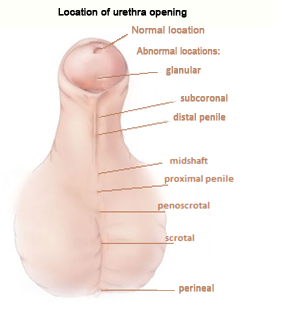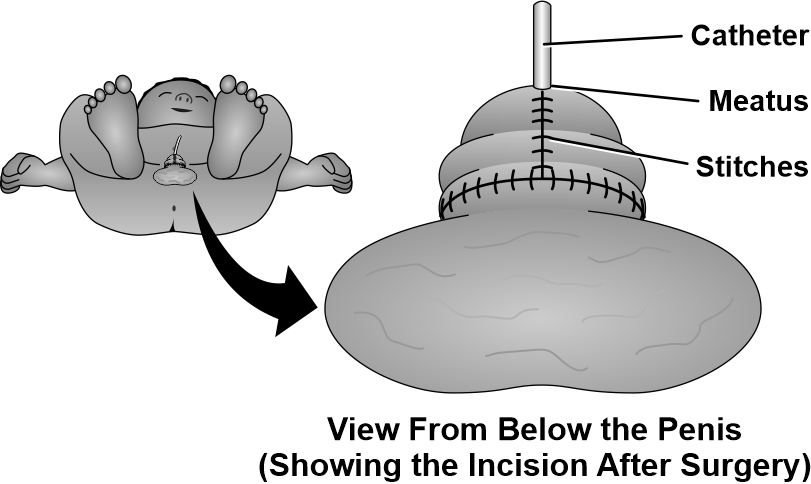Hypospadias
What is hypospadias?
Hypospadias is when the male urethra does not form correctly. The urethral opening, the hole where the urine comes out, is not in the normal position. Instead of the tip, it is on the underside of the penis. Hypospadias may be mild, moderate or severe depending on where the opening is on the penis. Boys with hypospadias are usually missing the underside of their foreskin, so that the foreskin forms a hood. There may also be a bend or curve (called chordee) in the penis when the boy has an erection.

What causes hypospadias?
The reason for hypospadias is not known, but it can occur in other family members.
How is it diagnosed?
Your child may have been diagnosed at birth by physical exam. Boys with hypospadias urinate with a stream that is often directed downward rather than out and away from the body. This condition, when left uncorrected, may make future sexual intercourse difficult.
How is hypospadias treated?
Usually surgery is recommended to correct the problem. The procedure takes 1-3 hours and your son will go home the same day. It is best done before your son starts potty training. If the hypospadias is severe, more than one surgery may be needed.
What happens during surgery?
Your son will receive general anesthesia to help him sleep and not feel pain during surgery. A caudal block (numbing medicine placed near the tailbone) will be given. The urethra is built using local tissue and the skin on the penis shaft is reconstructed. The child often needs a catheter or stent (a small plastic tube) to drain the urine during healing for several days after the operation.
Will my child be in pain?
Most children do well with the surgery. If your son is in pain, a pain medicine can help. You may alternate Acetaminophen (Tylenol® or another brand) and Ibuprofen (such as Advil® or Motrin®). Do not give aspirin because it may cause bleeding.
What can I expect after the surgery?

Before your child is discharged you will be given written information about their care at home and any questions you have will be answered.
- Diet: Resume regular diet as tolerated
- Activity: Your child may return to school or daycare when pain is well controlled. Avoid straddling activities, contact sports and swimming for 14 days.
- Wound Care: If your child has a dressing on the penis, follow your surgeon’s specific instructions for removal.
You will need to check the penis every 3-4 hours during the first day to monitor for bleeding and to make sure the catheter or stent is draining urine. The penis and scrotum will appear more red or darker and develop swelling and bruising.
- Apply an ointment to the surgical area to help prevent infection, like Bacitracin® twice a day for 2 weeks.
- Apply a generous amount of ointment (Aquaphor® or Vaseline®) to the surgical area with diaper changes, or at least 4 times a day.
- Glob the ointment on the surgical area and let it melt around the area. The ointment helps decrease irritation and protects the skin. You may notice off-white patches of healing skin around the surgical area and along the incisions, this is a normal part of the healing process.
- The catheter or stent is placed to allow a constant release of urine from the bladder through the newly repaired urethra and may cause some uncomfortable bladder spasms. Your surgeon will provide a prescription for medicine which should help relieve spasms. Avoid constipation, as this could cause an increase in bladder spasm pain.
- The stent is removed in the office 1-2 weeks post-operatively. Using a larger diaper over the regular size diaper can provide extra padding. Keep your child distracted during diaper changes to prevent pulling on the stent.
- Bathing: Sponge bathe your child for the first 2 days after surgery and then give short baths (5-10 minutes) in plain water for the next week. This will promote healing and can be soothing.
- Medicines: Pain can be controlled by alternating Acetaminophen (Tylenol® or another brand) and Ibuprofen®. Do not give aspirin because it may cause bleeding.
- If your child is prescribed an antibiotic, follow your surgeon’s specific instructions.
- Your surgeon may provide a prescription for medicine which should help relieve bladder spasms while the catheter is in place, follow your surgeon’s specific instructions. Do not give the bladder spasm medicine the night before his catheter is scheduled to be removed.
What to call the surgeon for:
- Any dressing problems: the dressing falls down to the base of the penis or the dressing seems too tight
- Significant swelling, bruising or bleeding at surgical area
- If the wound starts separating
- Fever with worsening redness or pus like drainage at surgical site
- Any problems with the catheter or stent:
- no urine coming out
- leaking around the tube
- the tube has moved or falls completely out
- Pain not controlled with prescribed medications
Call your primary care provider for any other concerns.
Follow-up care:
Follow-up with your child’s surgeon as directed following the surgery.
You must schedule an appointment with the urology nurses for stent removal 1-2 weeks after surgery, or as directed by your child’s surgeon. Call your surgeon’s office to schedule an appointment.
Questions?
This information is not specific to your child but provides general information. If you have any concerns, please call us at 612-813-8000.
This page is not specific to your child, but provides general information on the topic above. If you have any questions, please call your clinic. For more reading material about this and other health topics, please call or visit Children's Minnesota Family Resource Center library, or visit www.childrensmn.org/educationmaterials.
© 2024 Children's Minnesota
